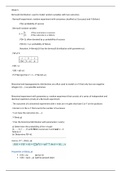Week 5
Bernoulli distribution: used to model random variables with two outcomes
. Bernoulli experiment: random experiment with outcomes classified as S (success) and F (failure)
. P(S): probability of success
. Bernoulli random variable:
. P(X=1): often denoted by p: probability of success
. P(X=0) = 1-p: probability of failure
. Notation: X~Bern(p) (X has the bernoulli distribution with parameter p)
. Pdf of X:
. E(X) = p
. V(X) = p(1-p)
. If X~Bern(p) then Y = 1 – X~Bern(1-p)
Binominal and hypergeometric distributions are often used to model a rv X that only has non-negative
integers 0,1...,n as possible outcomes
Binominal experiment with parameter p: random experiment that consists of a series of independent and
identical repetitions (trials) of a Bernoulli experiment
. The outcomes of a binominal experiment with n trials are n-tuples that have S or F on the positions
. Interest is in the rv Y that counts the number of successes
. Y can have the outcomes 0,1,…,n
. Y~Bin(n,p)
. Y has the binominal distribution with parameters n and p
,Calculating probabilities with excel:
. Let Y~Bin(n,p), then:
. f(k) = P(Y=k) = binom.dist(k,n,p,0)
. F(k) = P(Y≤k) = binom.dist(k,n,p,1)
Proportion of successes: consider a binominal experiment with n and p
. Y = #successes
. Proportion of successes:
. Properties:
. If n is very large, V is close to 0
Random experiment: n elements are randomly drawn from a population of size N with M successes and N-
M failures
. Y: number of successes in the sample
. If drawn with replacement:
. Y~Bin(n,p) with p=M/N
. If drawn without replacement: the n trials are not independent so there is no binominal distribution: Y has
a hypergeometric distribution (will not be treated in this course)
. Only has the result:
. If the population size is much larger than the number of draws, it does not mattes much whether
we work with or without replacement
Uniform distributions: used as models for continuous random variables Y with (more or less) equally likely
outcomes in bounded intervals
. Uniform distribution with parameters α and β, α<β
,. Y~U(α,β): Y has the uniform distribution with parameters α and β
Week 6
Family of continuous distribution: normal distribution
Joint probability distribution: discrete joint probability density function
Normal distribution: often used as a model for a random variable that is the result of many independent
contributions
. Plays an important role in hypothesis testing and confidence intervals
. Bijv. height/weight of a randomly selected person, asset returns, investment returns, central Limit
Theorem: Sample mean approximately follows a normal distribution, central Limit Theorem: Sample
proportion approximately follows a normal distribution
, In calculating probabilities, always make a sketch of the graph of the density and indicate the
corresponding area
Calculating probabilities with excel:
P(Y≤y) = norm.dist(y,μ,σ,1)
Calculating p-quantiles with excel:
such that P(Y≤b)=p: use norm.inv(p,μ,σ)
Standard normal distribution: the distribution N(0,1)
. Φ: cdf
. Φ(z) = P(Z≤z)
. For Z~N(0,1) the pdf is symmetric around 0
. For a>0:
. P(Z>a) = P(Z<-a)
. P(-a<Z<a) = 2Φ(a) -1






